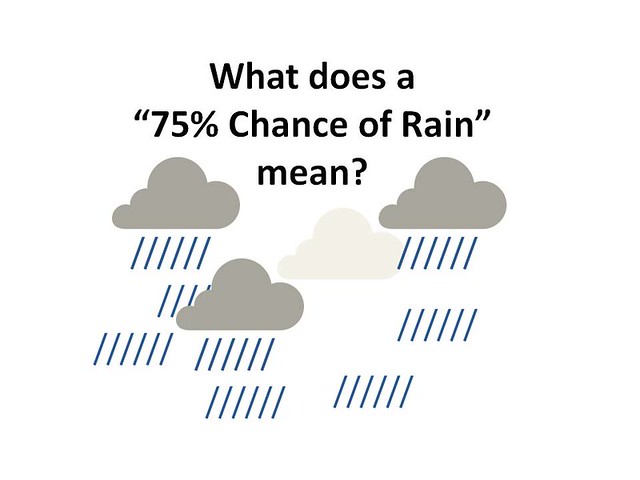What does a “75% Chance of Rain” mean?
October 15, 2014 by Samuel Seibert

subtitle: ‘How Statistics Revolutionized Science in the Twentieth Century’
Meta
-
Who should read this book?
Someone wanting to know the backstory for how the daily statistical techniques we use to make decisions were developed. This should be on the bookshelf of any statistician. It can also be considered a generally interesting book for a lover of history.
I read this book over the course of several months. It’s essentially a history and philosophy book delivered through a set of stories. I would usually read a few chapters, set it down for a month, then pick it up again. For me it was leisurely sort of read.
340 pages. There were about 70 sections that I noted or highlighted- about two or three ideas per chapter. Mostly I found something interesting about how techniques were generated, and occasionally my interest was piqued about a philosophical area of statistics.
David Salsburg does a fine job of taking what could be dry technical details about the origin of statistical techniques, and wrapping them around the stories of the people who developed them. Salsburg moves chronologically through the scientists’ lives to display how concepts grew over time.
Learn Your Roots. Salsburg wants us to see that breakthroughs happen because of individuals and their personal relationships. I think he wrote this to give recognition to these influential people.
Summary
The Lady Tasting Tea, looks through a collection of famous statistical theories, from the eyes of the people who developed them. As someone who uses statistical methodology daily, it was helpful to understand the thought processes behind the methodology. It helped me sharpen my thinking about the application of these techniques by understanding the problems their were originally designed to solve.
Two Quotes to Note
1.) “Through the 1970s and 1980s, Kahneman and Tversky investigated the way in which individuals interpret probability….From Kahneman and Tversky’s work, we have to conclude that the weather forecaster who tries to distinguish between a 90 percent probability of rain and a 75 percent probability of rain cannot really tell the difference.” – The Lady Tasting Tea, David Salsburg p. 306
When we are talking to someone in terms of probability, because of how we think about probability, if we hear 75% or 90% chance of rain all most people hear is, “It’s going to rain.”
An “X” probability of rain is not clear about what the probability represents.
For example: If Atlanta, GA, USA has a 25% probability of rain,
-
Does it mean that it will rain for 25% of that day?
-
Does it mean that 25% of Atlanta will be rained on?
-
Does it mean that it will be a light rain? (where 100% chance of rain is a heavy rain?)
Most people do not consider those ideas, we just think “I’m not going to need an umbrella today.”
When presenting probabilities specifics are not necessarily helpful. Most people do not distinguish between 75% or 90%. The probability only needs to be sufficient for making a decision. Anything more specific than that fails to register.
2.) “A careful examination of the resources available often produces the conclusion that it is not possible to answer that question with those resources. I think that some of my major contributions as a statistician were when I discouraged others from attempting an experiment that was doomed to failure for lack of adequate resources.” – The Lady Tasting Tea, page 265 Stella Cunliffe
Statisticians are typically consulted once a client has decided that they are ready to conduct analysis, only to find out that they can’t generate any helpful results because basic test set-up was never done. Cunliffe’s thought resonated with me since I’ve been asked to conduct analysis and “produce” a number. I knew full well that the analysis would be an abuse of statistical assumptions.
It can be hard in a businesses “just-it-get-done” enviroment to serve the organization with statistical analysis while abiding by all the correct test guidelines. Cunliffe’s statement alerts me to find ways to redirect a clients’ desire in wanting to conduct illegitimate analysis.
Challenges
1.) Do you realize how people are going to apply the probabilities you provide them?
Don’t invest too much time into developing a level of detail that isn’t going to materially alter their decision.
Understand that we all interpret an abstract concept like probability very differently, even with available definitions that everyone “should” follow.
2.) Do you produce results just for the sake of churning out numbers?
There is value in discouraging a client from carrying on analysis that will generate erroneous findings.
The point of most statistical application is to help us make more effective decisions. Perhaps show the client how carrying out the unplanned analysis will not just have a neutral, but a negative impact on their decision.
-SRS
P.S.
Because it would be poor form to not answer the question stated in the post title-
The 75% chance of rain is supposed to be interpreted as:
“…describes the chance of precipitation occurring at any point you select in the area.” – National Weather Service
It is the combination of both the certainty of rain falling somewhere in a given area and the percent of that space that will receive rain if the rain falls. It can be confusing because it is the multiplication of two probabilities which are assumed to be understood by people, but probably are not.
Disclaimer:
The Amazon links used in this post are affiliate links. That means if you click through the Amazon links and buy the book, it does NOT cost you anything extra but Amazon does send me a tiny % as a thank you.
If you found this helpful, and do decide to get the book, please purchase it through one of the links here.
Thanks ^_^
Posted in Book Review, Mind Transmogrification, Stats Master | Leave a Comment

Leave a comment